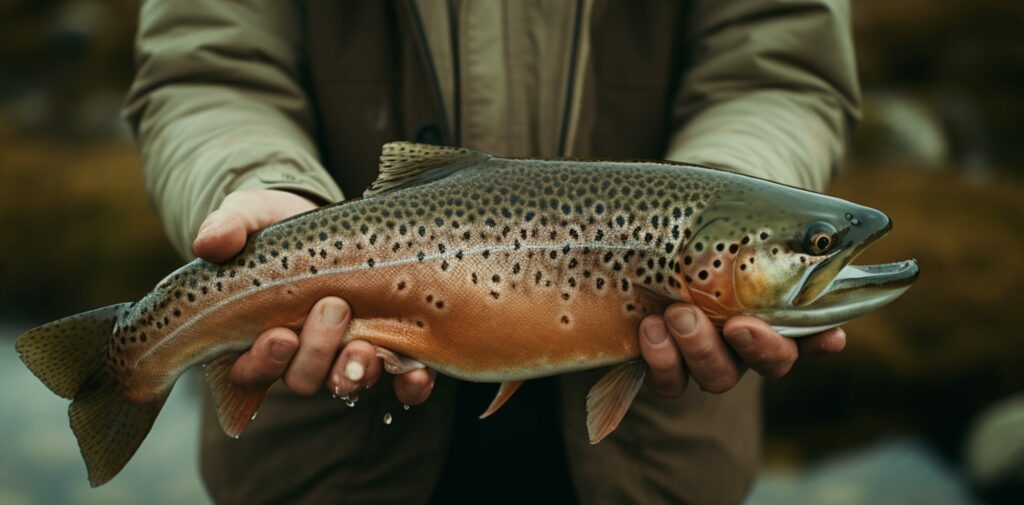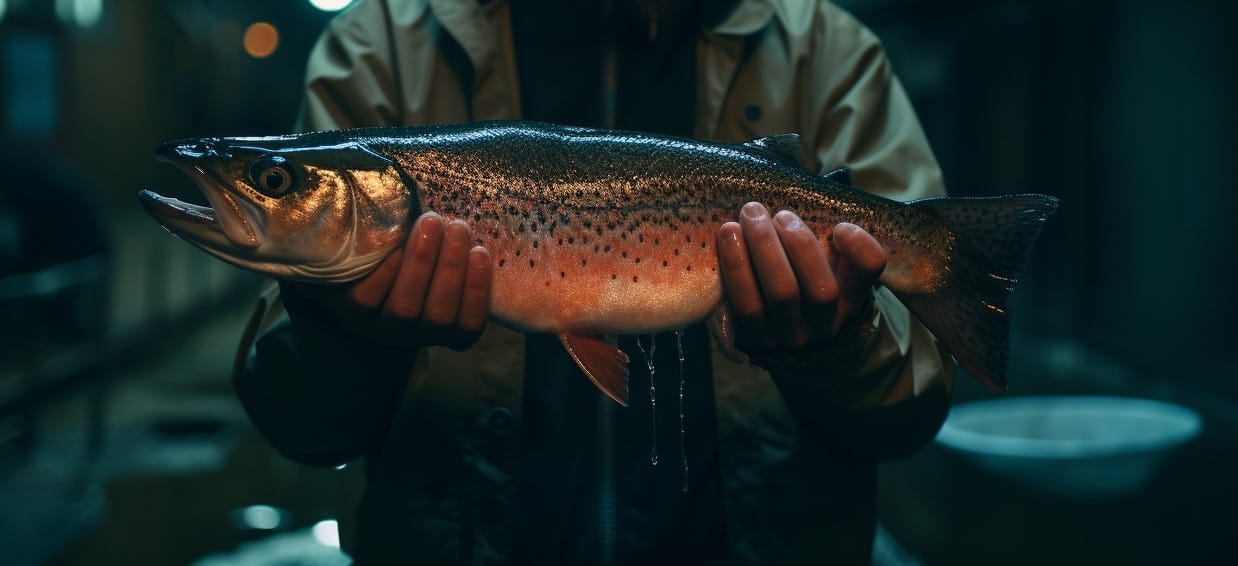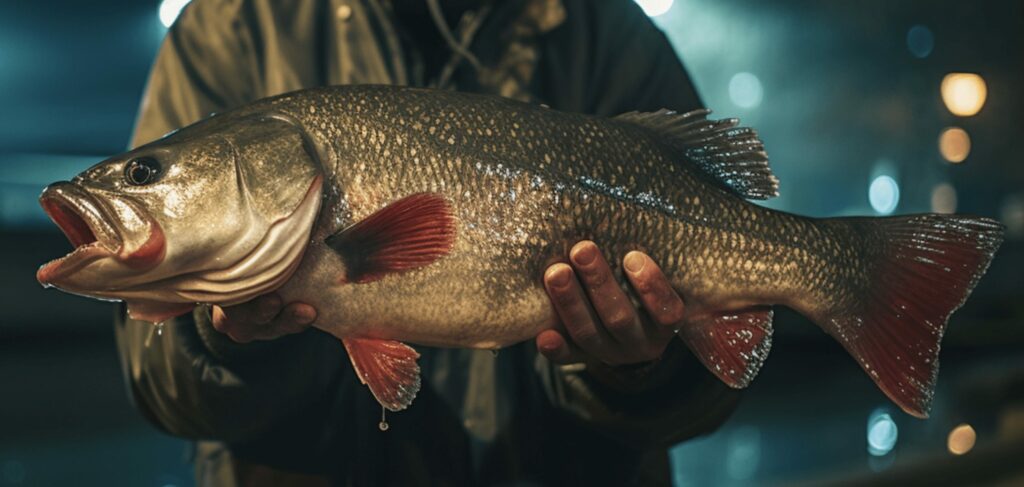Ever wondered why your daytime trout fishing trips aren’t as good as you’d like?
Well… I’d say then that maybe it’s time to switch off the sun and turn on the moonlight. Yeah, you heard me right—fishing for trout at night with worms can be a game-changer.
But hold on, it’s not as simple as grabbing a rod and a can of worms and heading to the nearest lake.
There’s a science to it, and that’s what we’re diving into today.
From understanding the nocturnal habits of trout to choosing the perfect gear and bait, this guide is your one-stop-shop for becoming the night-fishing guru you were born to be.
Let’s go!
How Do Trout Behave at Night?

Let’s go and give it a try to understand how trout behave at night so we can hopefully learn a thing or two for our next fishing trip at night:
Trout Are More Active at Night
First off, why are these fish more active when the sun goes down?
Well, it’s simple…
During the day, the sun’s rays penetrate the water, making it warmer. Trout don’t like that.
In fact, they prefer cooler temperatures, and that’s what nighttime offers. Plus, the cover of darkness gives them a sense of security from predators.
The Impact of Water Temperature
Water temperature plays a massive role in trout activity as these fish are most active in water temperatures ranging from 34 to 67°F.
So, when the sun sets and the water cools down, it’s like a dinner bell ringing for trout.
But here’s something I bet you don’t know: the moon phases also matter as the moon’s phases, particularly the new and full moons, have a significant influence on underwater visibility.
Trout Sense Food in the Dark
Now, let’s talk about how these fish find their food in pitch-black conditions.
Trout have a keen sense of smell and are sensitive to vibrations in the water.
So, when you cast your worm into the water, its movement sends ripples that attract nearby trout.
Here’s a pro tip: adding a bit of scent to your worm can make it even more irresistible. Think of it as adding seasoning to your bait. Garlic, anise oil, and even salt can make your worm the star attraction of the underwater world.
Choosing the Right Location and Time

You’re not just going to waltz into any body of water at any time and expect the trout to come running—or swimming, rather. No, you’ve got to be strategic about this.
So, let’s talk about where and when to set up shop for your night fishing adventure with worms.
Spots for Night Fishing for Trout: Shallow Waters and Banks
First things first, location.
You want to aim for shallow waters and banks. Why?
Because that’s where trout like to hang out at night. They come closer to the shore, making them easier targets.
I’ve had great success fishing near submerged logs and rocks as these natural structures act like trout magnets.
Ideal Times
You might think that any time at night is a good time for fishing, but that’s not entirely true.
The best hours are an hour before sunrise and an hour after sunset. This is due to what’s known as the “magic hour” in the fishing world.
During these times, the sky’s changing light levels make it difficult for trout to discern shapes and movements, making them less cautious and more likely to bite.
Plus, these transitional periods often coincide with increased insect activity, providing a natural feeding time for trout.
But hey, if you’re a night owl and want to fish in the dead of night, go for it. Just make sure the area isn’t bustling with boat traffic or other disturbances that could spook the fish.
The Role of Moon Phases in Determining Fishing Success
During a full moon, the increased light penetration into the water allows trout to see better and roam more freely in search of food. On the flip side, a new moon means less visibility, but it also means trout feel safer from predators, making them more active.
Now, here’s where it gets interesting.
These moon phases also affect the tides and water currents, which in turn influence the movement of smaller fish and aquatic insects—the primary food sources for trout. So, during these specific moon phases, you’ve got a combination of optimal visibility conditions and increased food movement, making it a prime time for trout to feed.
Understanding these lunar influences can give you a significant edge when you’re out there at night, especially when you’re using worms as bait. Worms already have a natural scent and movement that attract trout, but when you add the lunar advantage, you’re setting yourself up for a successful fishing trip.
The Impact of Seasons on Night Fishing
Now, let’s not forget about the seasons.
Each season brings its own set of challenges and opportunities.
- In the summer, the heat drives trout to deeper, cooler waters during the day. But come nightfall, they’re more likely to venture into shallower areas to feed, making it the perfect time to cast your worm-baited hook.
- Winter, on the other hand, is breeding season for trout. They’re more focused on love than food, but they still need to eat. Your best bet is to fish shortly after sunset when they’re most likely to feed.
And lastly, let’s talk about the weather.
A light rain can actually be your ally. The rain stirs up the water, dislodging insects and small fish from their hiding spots, creating a smorgasbord for trout.
But… steer clear of fishing during storms as the sudden drop in temperature and barometric pressure can make trout less active and more difficult to catch.
Important Gear for Trout Night Fishing with Worms

You need the right gear when it comes to night fishing for trout with worms, and I’m here to guide you through it:
Rod and Line
First things first, let’s talk about rods and lines.
You don’t need a heavy-duty rod for trout fishing.
In fact, I’d say that a light to medium-light rod will do the trick.
Now, when it comes to lines I can say that I’ve had great success with fluorocarbon lines, especially those that weigh at least 6lb.
Why?
Well, fluorocarbon is nearly invisible underwater, which is a game-changer when you’re trying to fool a trout in the dark.
Hook Size Matters
Size does matter here, folks.
You don’t want a hook that’s too big or too small; you want it just right.
And, I’ve found that a hook measuring around 6 inches in length works wonders as it’s large enough to secure the trout but not so large that it scares them off.
Also, a good tackle box with various sizes of hooks, different types of worms, and maybe even some marshmallows dyed in bright colors can give you an edge. Yeah, you heard me right, marshmallows. They float and can be a great attractant for trout.
Lighting
You’re going to need some light out there, but not just any light.
A good headlamp is essential as it keeps your hands free, which is crucial when you’re dealing with hooks, lines, and slippery fish.
Oh, I also recommend some reflective markers or even glow sticks to mark your line or float. It makes it easier to see any action happening at the end of your line.
Noise and Motion
This might sound counterintuitive, but making intentional splashes can attract trout.
Those ripples send vibrations through the water, catching the trout’s attention. But don’t go overboard; you’re not trying to create a tsunami.
A simple technique like worm drifting can be incredibly effective. Just cast your line upstream and let your worm drift back down toward you. It mimics natural movement, and trout can’t resist it.
Preparation and Techniques for Trout Night Fishing with Worms
You’ve got your gear, you’ve picked your spot, but how do you make sure that worm on your hook turns into a trout on your line?
Well, I’ve got some tried-and-true techniques that will make your night fishing trip a success.
Live Worms vs. Nightcrawlers
First off, let’s talk bait.
You’ve got two main options: live worms and nightcrawlers.
I’ve found that nightcrawlers are the real MVPs here as their natural scent and motion in the water are like catnip for trout.
Live worms work too, but nightcrawlers have that extra “rate of success” that can make all the difference when trying to catch trout at night.
Added Scent
Also, I’m a strong believer that adding scents can give you an edge, particularly with trout.
I’ve experimented with garlic, anise oil, and even some salt and it proved to be very successful for me. Just a dab will do ya, and you’ll be amazed at how it can attract those trophy trout.
The Art of Worm Drifting
Worm drifting is a technique you need to master as it’s simple but effective.
You just need to cast your line upstream and let your worm drift back down toward you. The natural movement is irresistible to trout.
But remember, don’t reel in too quickly; you want that worm to float naturally, mimicking real-life movement.
Also, making intentional splashes when casting your line can work in your favor. The ripples send vibrations through the water, which can attract a curious trout. So take that in mind too.
Tips for Catching Trout at Night With Worms
Alright, now you’ve got the basics down, but now it’s time to elevate your game with some tips to catch trout at night with worms.
Using Plastic Worms: The Unsung Hero
Plastic worms might not be as effective as live worms, but they’ve got their own set of advantages.
First off, they’re super convenient as you can keep a pack in your tackle box and not worry about them dying off.
Plus, they come in a variety of colors, which can be a game-changer in murky waters.
Me? I’ve had some success with Berkley PowerBait Honey Worms; they seem to do the trick when live bait is scarce. But there is nothing more attractive for trout than live worms, I give you that.
Combining Lures
If you’ve never tried using spinners along with your worms, you’re missing out on a golden opportunity.
Firstly, the spinner does an excellent job of grabbing the trout’s attention.
I mean, trout are curious creatures, especially at night when they’re actively hunting for food.
In that context, the spinner’s flash and vibration in the water mimic the movement of smaller fish, which is like ringing the dinner bell for trout. They can’t resist checking it out.
Now, once the trout is near, that’s where the worm comes into play. The natural scent and movement of a worm in the water are irresistible to trout. They see the worm wiggling on the hook, and it’s like they hit the jackpot—a tasty meal that’s easy to catch.
But here’s the kicker: when you use both a spinner and a worm, you’re essentially covering all your bases.
The spinner attracts trout from a distance, luring them in with its flash and vibration. Meanwhile, the worm serves as the perfect enticement once the trout are close. It’s having the best of both worlds.
The Scent Game: Beyond the Basics
You’ve probably experimented with the usual suspects like garlic and anise oil, but have you ever ventured into the world of cheese-scented worms? Yes, you read that correctly—cheese.
Cheese has a strong, pungent aroma that can travel through water quite effectively. It’s a scent that trout find intriguing, and it can make your worm bait even more irresistible.
I’ve tried this with a bit of blue cheese, and the results were astonishing. The trout seemed to be drawn to the bait like moths to a flame.
But here’s the thing: not all cheese scents are created equal. You want to go for something that has a strong, natural aroma but isn’t overpowering. Think along the lines of cheddar or gouda.
And let’s not forget the importance of moderation. You don’t need to slather your worm in cheese; a small dab will suffice. The goal is to enhance the natural scent of the worm, not mask it entirely.
Now, a word of caution: avoid using scents that could repel trout. Citrusy or spicy scents are a no-go. Trout have a keen sense of smell, and the wrong aroma can send them swimming in the opposite direction.
Frequently Asked Questions
What Time Do Trout Bite the Most?
Trout are most active during the twilight hours—just an hour before sunrise and an hour after sunset. Why? Because the dim light makes them feel secure enough to venture out and feed, but it’s not so dark that they can’t see anything. Plus, the water temperature is usually just right during these times, making the trout more active.
What’s the Best Bait for Trout Fishing at Night?
Consider using spinners or scented baits. Spinners create vibrations in the water that trout can sense, making them an excellent choice for night fishing. As for scents, think garlic, anise oil, or even cheese. Yes, cheese! A dab of a strong-smelling cheese can make your worm bait irresistible.
How Do Moon Phases Affect My Fishing Success?
New moons and full moons offer the best fishing conditions. The reason? These phases affect underwater visibility and, consequently, the trout’s feeding patterns. So, if you’re planning a fishing trip, try to align it with these moon phases for maximum success.




